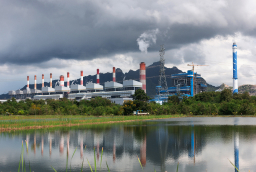Precious metal refining Gas cleanup and product recovery
Introduction
In most cases, a chlorination process is used for the refining and purification of the precious metal, mainly gold and silver. The process generates fumes containing hazardous acid gases and sub-micron particulate, including gold and silver. Fume treatment of these gases presents a challenge and an opportunity. Removal and separation of the acids and sub-micron particulate is difficult, however, the higher the removal, the greater the product recovery and financial benefit.
Challenge
Flue gases from the refining process contain hazardous contaminants like salts, chlorine and hydrogen chloride that need to be cleaned. In addition, flue gases contain residual valuable metals such as gold and silver that could be recovered in the gas cleanup process. Different treatment technologies (including ESP, conventional venturi etc.) have been tried with limited success. Combined acid and particulate systems will make product recovery difficult and uneconomical.
A major North American precious metals refinery selected Macrotek to design and supply a gas cleanup and product recovery system for their multiple refining furnaces.
Solution
For this type of process, a wet scrubber or absorber system is required for the acid gas cleanup while a high efficiency venturi scrubber offers maximum removal for the particulate and metals. Various venturi scrubber technologies are available on the market, however Macrotek has developed innovative venturi scrubber technology for maximum removal efficiency – the Flooded Disc Venturi (MVA).
Macrotek implemented a two stage process to meet the gas cleanup and product recovery objectives of the refinery. Product recovery was optimized by using the high efficiency MVA while acid neutralization was completed in the counter-current absorber following the MVA.
Previous experience with venturi scrubber designs in which energy dissipation took the form of gas pressure drop shows the main factor in contact efficiency between primary particles and target water droplets was turbulence. These observations led to the almost universal acceptance of the energy input concept as a means for correlating scrubber efficiency. This correlation was based on the assumption that scrubbing liquid exists in regions of energy dissipation and in quantities sufficient to provide an adequate collision area for sub-micron particulates.
Macrotek provided a scrubber system solution consisting of two parts: the flooded disc contactor and the separator which included an internal mist eliminator. The mist eliminator included a separator vessel and chevron element at the top of the vessel. Past practice was to utilize cyclonic mist eliminators, however today’s emission requirements demand a comprehensive and efficient mist eliminator system. All of Macrotek’s latest models include high efficiency chevron style mist eliminators.
The contact area of the gas-liquid interface of Macrotek’s MVA scrubber is large (circumference of the disc) and provides for uniform and optimum atomization of the liquid. A system of suspended contaminant, particulates, liquid droplets, and saturated gas all in highly turbulent flow exists in, and immediately downstream of the annular orifice.
Collection of the contaminant particles by the liquid droplets is achieved primarily by inertial impaction with the turbulent eddies providing the relative velocity, or driving force. The liquid droplets agglomerate and are separated from the gases in the separator vessel.
Vertical movement of the disc in the converging throat provides a means for varying the area of the annulus over a very large range. This allows flexibility and capacity to adjust for varying flow conditions.
The collected particulate material is filtered and further treated to recover the valuable precious metals. Particulate-free flue gas containing the acids is treated in a custom designed, fit for purpose counter-current absorber. Alkaline reagent is used to convert the hazardous fumes to stable salts.
Conclusion
Conclusions are that performance on a given application is a function of pressure drop and particle size distribution. In addition, the actual performance of the Macrotek MVA Scrubber is significantly better than predicted by the theoretical model, outperforming other conventional venturi scrubbers.
This innovative, high efficiency flooded disc venturi scrubber provides the basis for a system that includes very high particulate removal and product recovery. The second stage absorber provides for complete neutralization of the acid gas fumes.
Macrotek’s solution met and exceeded environmental regulations and product recovery for the precious metal refinery was over 99%.
These favourable results have made the design concept of a high efficiency flooded disc venturi scrubber combined with a separator and an acid gas scrubber-absorber system the technology of choice for major precious metal refiners in North America. This was Macrotek’s fifth installation of its kind.




